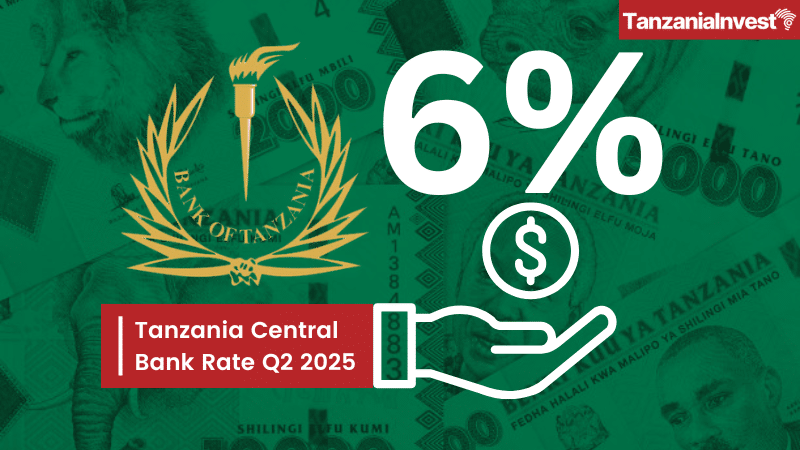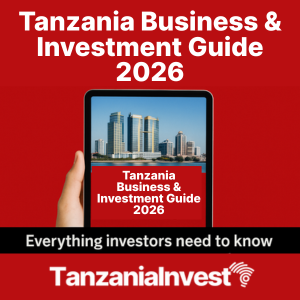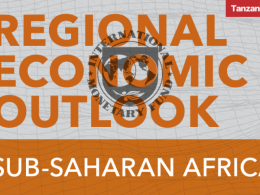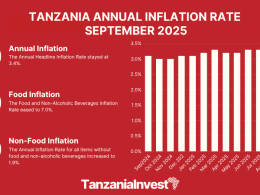The Bank of Tanzania has announced that the Central Bank Rate (CBR) will remain unchanged at 6% for the first quarter of 2025.
The Bank’s Monetary Policy Committee (MPC) met on 3rd April 2025 to review the recent economic performance and outlook for the second quarter of 2025. Based on the assessment, the MPC maintained the central bank rate at 6%.
Consequently, the Bank will implement monetary policy to ensure the 7-day interbank market rate moves within a range of 4-8%.
In its Monetary Policy Committee Statement, the MPC observed that the outlook for inflation and economic growth remains within the desired paths, but global trade policies and geopolitical conflicts might affect domestic inflation and output.
Therefore, maintaining the central bank rate will help to minimize negative spillover effects of trade tariffs and geopolitical conflicts on the economy.
The Committee noted that economic activity in advanced economies and emerging markets improved in the first quarter of 2025, and the growth outlook remains strong.
However, trade tariff uncertainties and geopolitical conflicts might undermine global growth. Inflation has substantially eased and converged to targets due to a decline in the previous economic shocks and monetary policy tightening.
Because of this progress and the projected low inflationary environment, many central banks reduced policy rates. However, trade tariff announcements heighten risks to the inflation outlook.
The MPC observed that, since its previous meeting in January 2025, domestic economic conditions have continued to improve, and the outlook remains favourable.
This optimism is also reflected in the Market Perception Survey and the CEOs Economic Perception Survey conducted in February 2025.
Furthermore, Moody’s credit rating report released in March 2025 maintained Tanzania’s rating at B1, with a stable outlook.
The Committee observed that the risk to the economic outlook remains low; however, heightened trade tariffs and geopolitical conflicts might elevate it. The domestic performance and outlook are summarized as follows:
i. Liquidity in banks increased due to fiscal operations and seasonal decline in currency outside banks. As a result, banks reduced demand for reverse repo and borrowing through the Lombard loan facility. However, the MPC observed that small banks experience difficulties in obtaining liquidity at affordable cost from large banks, contributing to the 7-day interbank rate to fluctuate close to the upper band of the CBR.
ii. The economy sustained strong performance in 2024, supported by both public and private sector investment. In Mainland Tanzania, the economy is estimated to grow at 5.5% in 2024, compared with the projections of 5.4% and 5.1% in 2023. The growth was driven by agriculture, financial and insurance, mining and quarrying, and construction. Tourism, a cross-cutting activity, also contributed significantly to the growth outturn. For the first quarter of 2025, growth is estimated to reach 5.5%. The Zanzibar economy grew by 7.2% in the fourth quarter of 2024, up from 2.2% in the last quarter of 2023, mainly on account of accommodation and food services, which are largely influenced by tourism, and wholesale and retail trade activities. This strong growth is expected to continue in the second quarter of 2025, reaching 6.1% in Mainland Tanzania and 6.5% in Zanzibar, driven by the same economic activities.
iii. Inflationary pressures remained subdued, due to monetary policy action, adequate food supply, prudent fiscal policy, and moderation of global energy prices. Headline inflation in Mainland Tanzania was 3.1% in 2024, lower compared with 3.8% in 2023, below the country’s target of 5%, and consistent with SADC and EAC convergence criteria. During the first quarter of 2025, it averaged 3.2% in Mainland Tanzania. In Zanzibar, headline inflation eased to 5.1% in 2024 from 6.9% in 2023. In February 2025, inflation decreased to 4.8% from 5.3% in the preceding month and 5.1% in a similar month in 2024, because of a decrease in food inflation. Inflation is projected to remain low at around 3.2% in the second quarter of 2025.
iv. Money supply growth remained strong, at more than 12% in 2024, consistent with the monetary policy stance. The growth of the money supply was largely contributed to by private sector credit. In the first quarter of 2025, the money supply increased in line with the improvement in liquidity. Credit to the private sector grew by 12.7%, where personal loans, mainly credit extended for small and medium enterprises (SMEs), accounted for the largest share, followed by agriculture, trade and manufacturing activities.
v. The banking sector was stable with sufficient liquidity, profitable and adequately capitalized to withstand shocks. The quality of assets was satisfactory, as reflected by a low non-performing loan ratio of 3.6%, which is below the desirable level of not more than 5%. The MPC observed that this favourable condition of the banking sector is expected to continue in the second quarter of 2025.
vi. Fiscal performance was satisfactory. Tax revenue in Mainland Tanzania and Zanzibar was on target in the third quarter of 2024/25, as in the previous two quarters, attributable to improved tax administration and compliance. The governments continued to rationalize expenditure to match available resources. Public debt remains sustainable with a moderate risk of debt distress, reflecting the fiscal prudence.
vii. The external sector of the economy continued to improve. In the year ending March 2025, the current deficit was about 2.6% of GDP compared with 3.7% in the corresponding period in 2024, explained by an increase in exports, particularly tourism, gold, cashew nuts and tobacco. For Zanzibar, the current account balance is estimated to have a surplus of USD 563.5 million, higher than a surplus of USD 407.4 million, largely on account of the increase in tourism receipts.
viii. Foreign reserves remained adequate throughout the first quarter of 2025. The reserves amounted to more than USD 5.6 billion, covering 4.5 months of projected imports of goods and services, and are expected to remain at the same levels in the second quarter of 2025. Based on the improvement in the current account position, the MPC observed the exchange rate pressures experienced in the first quarter of 2025 as seasonal, expected to dissipate as the low season of foreign exchange wanes.
To conclude, the MPC expects the Bank to continue implementing reforms in the interbank market to improve interest rate determination, monitor closely risks to inflation and output, and take the appropriate monetary policy actions. The MPC meets quarterly to assess performance and outlook for the economy and will convene again in the first week of July 2025 to set the central bank rate for the third quarter of 2025.










